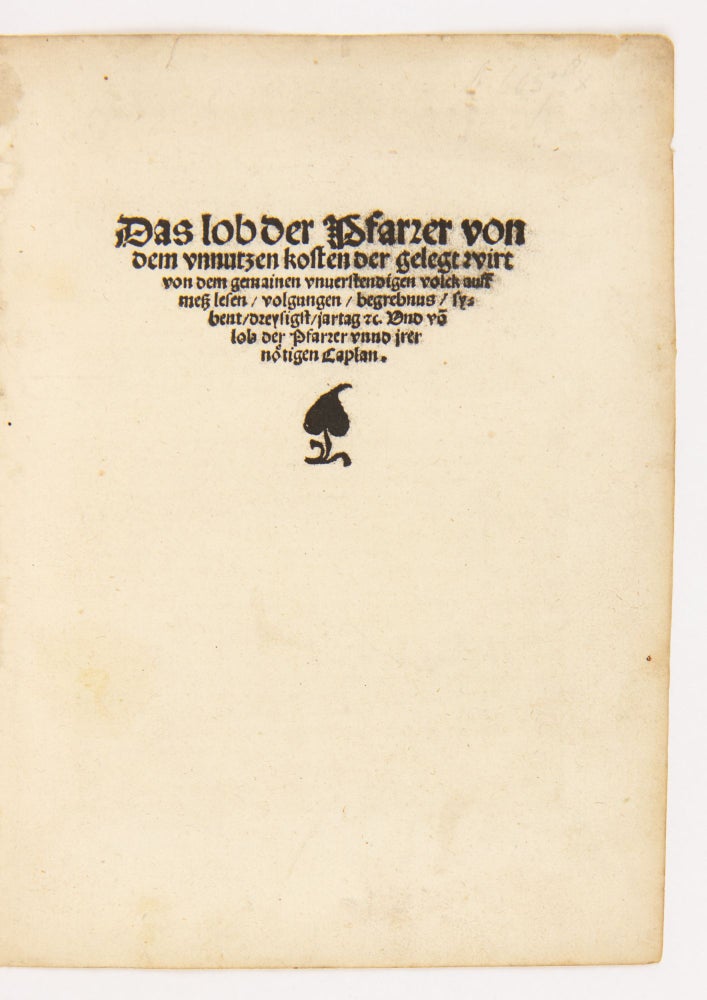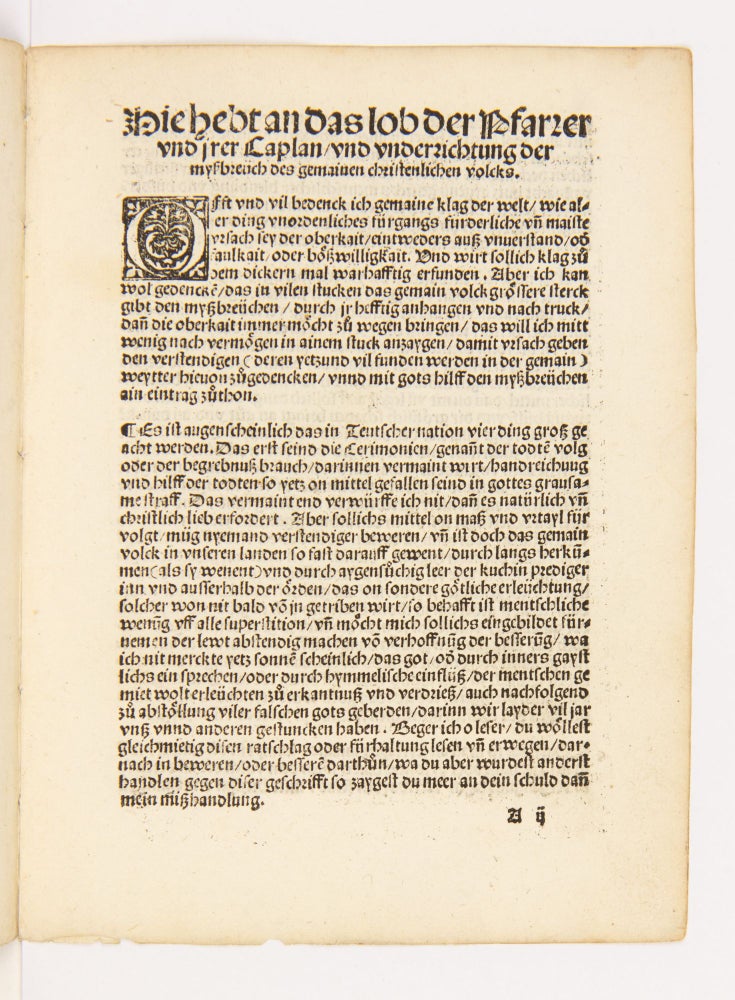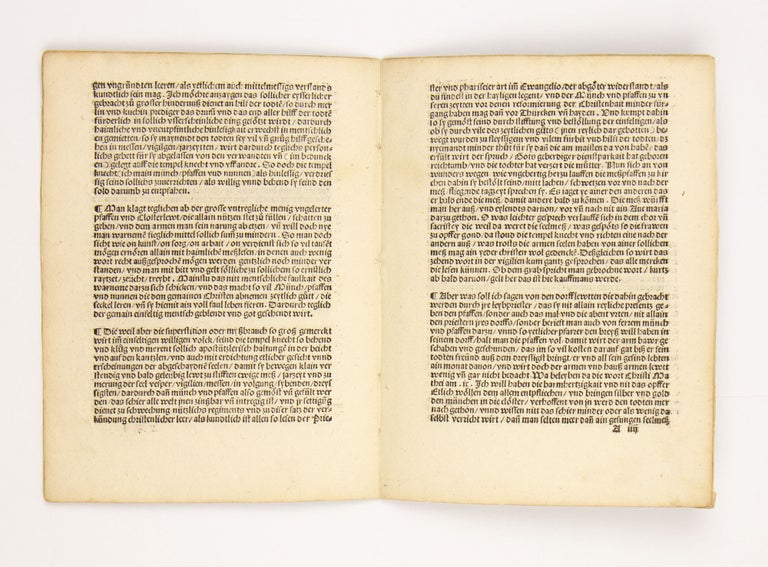Das Lob der Pfarrer von dem unnutzen Kosten der gelegt wirt von dem gemainen unverstendigen Volck auff Meß lesen, Volgungen, Begrebnus, sybent, dreysigst, Jartag etc. Und vo(m) Lob der Pfarrer unnd jrer nötigen Caplan.
[Augsburg: Sigmund Grimm and Marx Wirsung], 1522.
Price: $4,500.00
Quarto: 19.2 x 14.3 cm. [10] p. Final leaf blank and present.
ONE OF THREE EDITIONS printed in 1522. The first ed. appeared in 1521. Place, printer, and year from VD16.
A very good copy in modern paste-paper wrappers. Small adhesion scar to blank portion of title, far from text.
An early edition of Eberlin’s “In praise of parish priests Concerning the useless sums paid out by the common, unsuspecting people for mass readings, funerals, internments, sevenths and thirtieths, etc. And in praise of parish priests and their necessary chaplains.” This is the seventh -and the first composed- of Eberlin’s “Fünfzehn Bundsgenossen” (“The Fifteen Confederates”). Eberlin offers advice on how to truly honor the dead, not by expending money and energy on funerals and special church ceremonies that largely support the “fat, full, hypocritical, self-serving, blackmailing monks, priests and nuns” but rather by providing for the family members of the departed, giving alms to the poor, helping the needy, supporting the local parish priest who ministers to the community, and through earnest prayer:
“Unfortunately, human superstition has reached the point that much money and effort is expended on things such as vigils, candles, the endowment of anniversary and perpetual masses, which accomplish at best only part of the intended goal of helping the dead. Similarly, if a person dies, all efforts are turned toward preparing the pall; toward the bier; and toward useless and very expensive preparations, like wax and candles; toward hiring a great number of priests; toward arranging wearisome, excessive and unobserved vigils. I don’t deny that all this serves worldly purposes: it brings frivolous esteem to the living. But that it serves the dead as a direct and powerful means of consolation cannot be established except through self-serving, unsubstantiated teachings, which are convincing only to those of mediocre understanding.
“I wish to show that such outward practices actually serve as a great obstacle to helping the dead. The fairy tale and kitchen preachers have established that the beginning and end of all help for the dead comes especially from such outward, showy things, through which hidden and unnoticed neglect grows in the human heart, so that the people come to believe that the dead receive sufficient help through masses, vigils and anniversary masses. And as a result of this their relatives leave off offering daily personal prayers for them and (so they intend) hand them over to the temple servants and others. But the temple servants (I mean the monks, priests and nuns) are as careless and weary in performing these as they are nimble and determined in receiving payment for them.”(Eberlin, Seventh Confederate)
“The ‘Fifteen Confederates’ are a collection of pamphlets ostensibly written by a group of laymen, the confederates, who had sworn together to address the religious, social, economic, and political problems facing the German nation in the early years of the Protestant reformation. They came off the presses sometime in the fall of 1521, in the unsettled atmosphere after Martin Luther’s hearing at the Diet of Worms and subsequent disappearance, without indication of author, publisher, or date or place of publication. Evidence from other sources indicates that they were available at the Frankfurt book fair by 27 September and that very quickly they were known throughout the German-speaking lands.”(Dipple, The Fifteen Confederates: Johann Eberlin von Günzburg, p. 6)
After their initial publication by the Basel printer Pamphilius Gengenbach, the 15 Confederates were reprinted, collectively, three times: once by Jörg Nadler in Augsburg and twice by Johann Eckhart in Speyer. The seventh Confederate was by far the most popular. It ran through six editions: two by Gengenbach in Basel and one each from presses in Zurich, Augsburg (this edition), Speyer, and Zwickau.
“Wilhelm Lucke argued convincingly that the [twelve] works were written in an order different from that in which they appear in the collection. He suggested further that the idea of the collected work had not yet occurred to Eberlin when he wrote these first components. Lucke’s revised chronology for the composition of the Confederates, with a few minor modifications by Gottfried Geiger, is now generally accepted by Eberlin scholars… According to the revised order of composition, the first Confederates to be written were numbers seven, two, three, and four. These deal with issues of concern to inhabitants of monasteries, touching either the nature of their vocation or their interactions with the laity: the sufficiency of the parish clergy and the spiritual services provided by them, the Lenten fast and its applicability to both those in monasteries and the laity, the plight of cloistered women, and the canonical hours. Taken together, they envision a reform of the monastic life and its place in society that would have fundamentally changed the nature of the institution…
“Wilhelm Lucke characterized this group of Confederates as focusing on individual abuses in the church, but as remaining within the bounds of orthodoxy and recognizing the authority of the church throughout. While they draw on elements of Luther’s reform plan, especially as outlined in the Address to the Christian Nobility, they avoid mentioning Luther by name. Gottfried Geiger and Günther Heger argued further that while Eberlin derives specific complaints from Luther’s work, the basic thought of these pamphlets reflects the Christian humanist reform program of Erasmus of Rotterdam.”(Dipple, p. 6-7)
“Johann Eberlin's origins are shadowy and disputed. Purportedly born sometime between 1460 and 1470 to a Swabian family of peasant stock from the village of Kleinkotz near Günzburg, the first sound textual traces of his life appear in 1489. He matriculated at the University of Basel as an ordained priest from the diocese of Augsburg. The next reliable information as to his whereabouts does not surface until 1517, when it becomes clear that he had entered the Franciscan order, probably serving in an Alsatian monastery; his writings evidence a strong familiarity with Strasbourg. By 1519, he had spent time at the university of Tubingen; at the beginning of 1521, after a conflict with his superiors, he was transferred to Ulm. He quickly gained a reputation as a troublemaker and.. not coincidentally, he left the order at that time and openly came out in favor of Luther’s evangelical movement.”(Letterer, “Welfare Land: Johann Eberlin von Günzburg and the Reformation of Folly”.)
“By any account, Eberlin’s was an important voice in the early years of the reformation. as such, it provides us with valuable information about the reformation’s message as it passed through the medium of popular pamphlets. one of the most striking features of Eberlin’s writings is the fact that only gradually do many of the central themes of the new Wittenberg theology emerge in them. only after he moved to Wittenberg and immersed himself in the theology of the movement there did he really begin to speak as we would expect a Protestant reformer to speak. Luther and those associated with him do appear in Eberlin’s earlier utterances, but they serve as beacons for the reform-minded in the German-speaking lands, associated more with addressing abuses in the church and society than with the finer points of reformation theology. Luther takes his place alongside Erasmus, Ulrich von Hutten and a host of other reformers, primarily from the ranks of the renaissance humanists.
“The subtitle of Christian Peters’ biography identifies Eberlin as a Franciscan reformer, humanist, and conservative reformer. The Fifteen Confederates occupy a crucial position in this evolution, chronicling his movement through the first two phases and his entry into the third. in the process, they give us a clear indication of how broadly reform could be conceived at the beginning of the sixteenth century.”(Dipple, The Seventh Confederate, p. 18).
VD16 E 107; Kuczynski number 626





